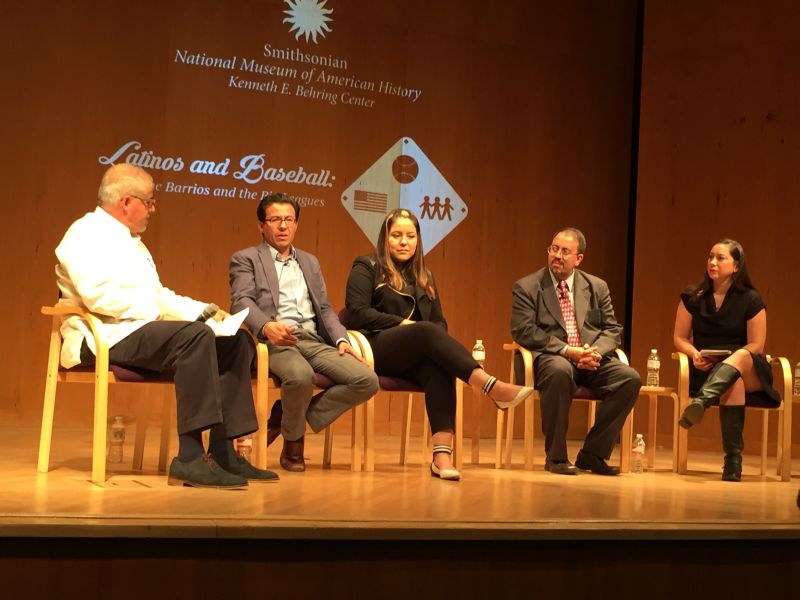
Camarillo, Calif., Jan. 13, 2016 — CSU Channel Islands (CI) Professor of Chicana/o Studies Jose Alamillo, Ph.D., helped launch an exhibit for the Smithsonian’s National Museum of American History called “Latinos and Baseball: In the Barrios and the Big Leagues.”
Alamillo and other scholars from across the U.S. met with representatives at the Smithsonian in October 2015. At the beginning of 2016, the Smithsonian announced a multiyear, nationwide collecting initiative to find, identify and curate artifacts that reflect the social and cultural influence of the game on Latino communities across the United States.
“We wanted to highlight the positive contributions Latinos have made to American society,” Alamillo said. “What better way to do that than with baseball, America’s pastime?”
Representatives from Smithsonian’s National Museum of American History contacted Alamillo following the exhibit he organized in spring of 2015 at the John Spoor Broome Library called, “A League of Their Own: Mexican American Women in Baseball and Softball and their Struggle for Gender Equality.”
The exhibit included memorabilia from Latinas who played regional baseball and softball in the 1940s and ‘50s, and featured former team members as panelists.
Alamillo stressed that both men and women with Latin American roots were heavily involved in baseball since its inception in America.
“When people think of Los Angeles baseball, they think of the Dodgers, but before the team arrived in 1958, there were hundreds of baseball teams throughout Southern California,” Alamillo said. “And many of them had Latino team members.”
Alamillo added that about 25 percent of today’s Major League Baseball teams are made up of Latino players.
Organizers at the Smithsonian thought Alamillo would provide valuable feedback for their mission to create an exhibit on Latina/os’ role in American baseball.
“Baseball has played a major role in everyday American life since the 1800s, providing a means of celebrating both national and ethnic identities and building communities,” said John Gray, director of the Museum of American History. “Through the lens of baseball, the Smithsonian seeks to illuminate the rich history and culture of Latinos and their impact on American culture and society.”
The Smithsonian is working with CI and nine other partner organizations as they seek out stories and objects from the U.S. and Puerto Rico that will help tell the story of Latina/o baseball in America.
The items could include baseball equipment, stadium signs and game memorabilia, such as handmade or mass-produced jerseys and tickets as well as food vendor signs, home movies and period photographs. Curators will select objects based on the stories they represent as well as insight into personal, community and national narratives involving the national pastime.
There will be three major collecting events in 2016, one in New York and two in California, which are designed to link to communities that might have memorabilia or oral histories to share.
The first community collecting event will be Feb. 19-20 at CSU San Bernardino’s John M. Pfau Library, home of the Latino Baseball History Project.
Alamillo said CI is involved with the second event on July 17 at the LA Plaza de Cultura y Artes near Olvera Street in downtown Los Angeles.
The third is scheduled for September at La Casita Cultural Center at Syracuse University in New York.
CSU Los Angeles and other partners will host similar events later in 2016 and into 2017.
Alamillo said July’s event in Los Angeles will be part of a baseball-themed family day sponsored by the LA Plaza de Cultura y Artes. The baseball exhibit will be called “Peloteros in Paradise: A Los Angeles Béisbol Story.”
# # #
About California State University Channel Islands
CSU Channel Islands(CI) is the only four-year, public university in Ventura County and is known for its interdisciplinary, multicultural and international perspectives, and its emphasis on experiential and service learning. CI’s strong academic programs focus on business, sciences, liberal studies, teaching credentials, and innovative master’s degrees. Students benefit from individual attention, up-to-date technology, and classroom instruction augmented by outstanding faculty research. CI has been designated by the U.S. Department of Education as a Hispanic-Serving Institution and is committed to serving students of all backgrounds from the region and beyond. Connect with and learn more by visiting CI's Social Media.
